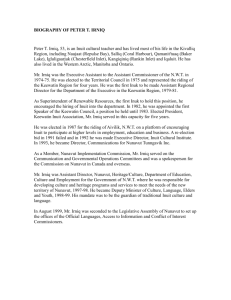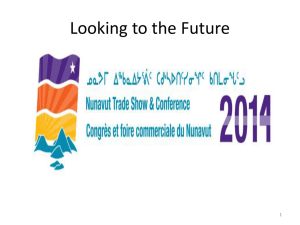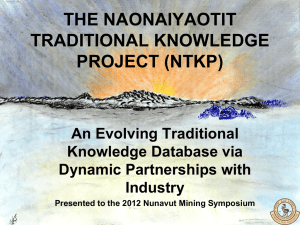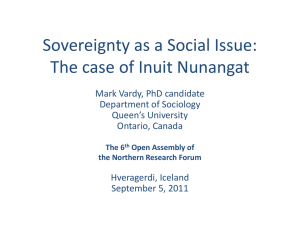Sivuniksamut Illiniarniq: Future Schools of Nunavut
advertisement
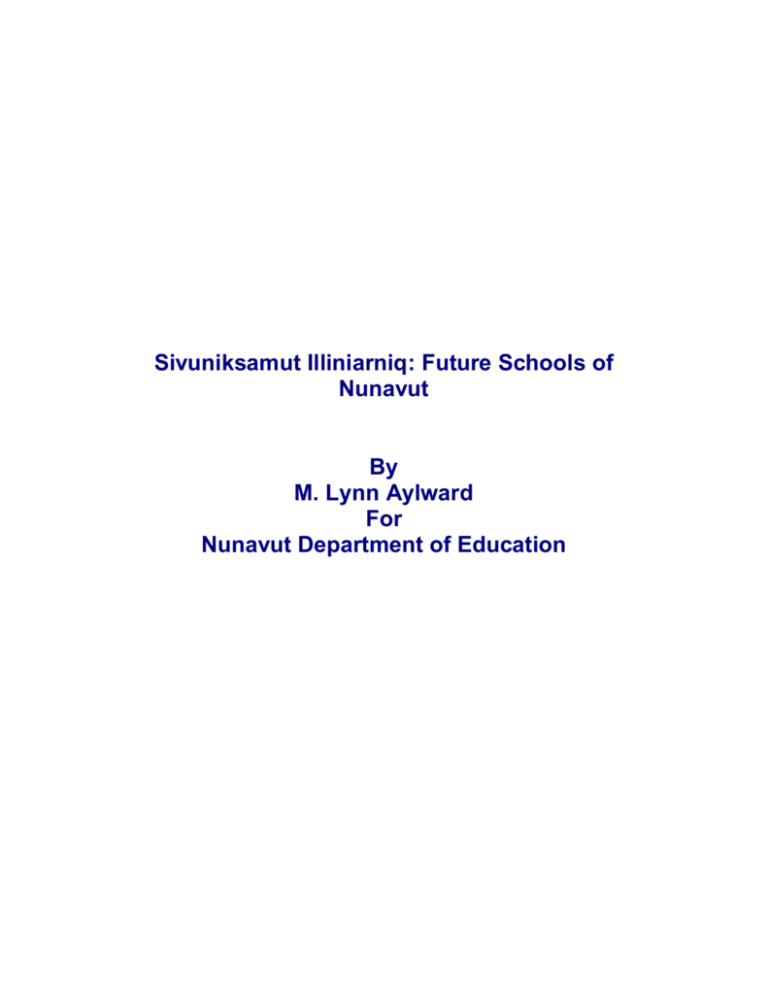
Sivuniksamut Illiniarniq: Future Schools of Nunavut By M. Lynn Aylward For Nunavut Department of Education What is Sivuniksamut Illiniarniq? In exploring multiple graduation options for Nunavut students, the Department of Education is committed to the restructuring of Nunavut schools according to the principles of Inuit Qaujimajatuqangit. The name adopted for the restructuring consultation was given by an Elder. The name is Sivuniksamut (for our future, your future, my future) Ilinniarniq (continuing the cycle of learning). Sivuniksamut Illiniarniq is the goal of the Department of Education and the results of extensive consultations with Nunavummiut about how the future should look for all learners are presented in this report. Sivuniksamut Illiniarniq recognizes the important role of Community Learning Networks as a key element of community capacity building. Community Learning Networks are community controlled systems aimed at furthering community development and enriching the lives of all its members. These networks rely on peer to peer learning and the creations of communities of practice. The focus is on community based knowledge not information transfer. Also, though they are locally created, the networks are meant to have reach beyond the community level. Community Learning networks in Nunavut are necessary to support lifelong learning that both complements and enriches the secondary school experience. Sivuniksamut Illiniarniq is an approach to education that has been developed on the foundation of Inuit Qaujimajatuqangit; acting upon the objectives of Pinasuaqtavut ( Bathurst Mandate) emphasizing the inclusion of all students within an Inuuqatigiinniq learning environment. This approach also necessitates substantive consideration of the Languages of Instruction research Aajjiqatigiingniq and Qulliq Quvvariarlugu completed by the Department of Education in 2000. Sivuniksamut Illiniarniq means addressing the needs of the individual learner; building personal capacity while considering how that individual grows and contributes to their community. Pinasuaqtavut Pinasuaqtavut envisions a Nunavut that is healthy in every way; Inuuqatigiittiarniq. It emphasizes self-reliance through cooperation and collective responsibility as well as individual accountability. Therefore, respect, self – assurance, strength and caring must be an integral part of school learning. Nunavut residents would like increased access and participation with the various government institutions. One implication of this call for unity and simplicity is that the Nunavut school system must be more open and responsive to community needs. With respect to the goals of continued learning, Pinasuaqtavut advocates for schooling that supports a bilingual society, and preservation of the culture, values and language of Nunavut’s origin while at the same time being inclusive to all residents. The role of teacher begins within the family unit and positions elders as leaders. Sivuniksamut Illiniarniq means ensuring that schools are places where Inuit Qaujimajatuqangit lives. As a foundation for Nunavut schooling Inuit Qaujimajatuqangit becomes more than the ‘add on’ approach of cultural inclusion programs or the ‘dance, dress and diet’ content of many ‘multicultural’ philosophies. The person, language, culture, and environment cannot be separated and academically addressed as individual pieces. Having Inuit Qaujimajatuqangit be the lens through which we view all educational efforts necessitates a realization that the learning process is sustained through connections to community values, beliefs and practices. The Role of Inuit Qaujimajatuqangit in Nunavut Schools It is not possible to have the Inuit Qaujimajatuqangit principles as the foundation of Nunavut schooling and leave the ‘system’ of education as it is. Substantial systemic change is essential to the Sivuniksamut Illiniarniq process. In working towards a collaborative relationship and the ‘common good’ – the Inuit Qaujimajatuqangit principles of Pilriqatigiingniq; Aajiqatigiingniq; and Pijitsirarniq call us to develop shared leadership models; consensus building and strong relationships within schools. How might administrative structures, disciplinary measures or grade groupings be reconsidered in light of this call to harmony? How can learning assessment, recognition of group accomplishments, individual achievement and goal setting be addressed in a supportive manner? The principle of Avatimik Kamattiarniq is the process of working to support and maintain environmental wellness in recognition of personal responsibilities and respectful behaviour. How is the interdependent nature of this relationship with the environment reinforced and extended through present school study? What learning models or practices could be put in place to nurture a more complete understanding of this component of wellness? The principle of Qanuqtuurungnarniq seeks to promote resourcefulness, flexibility and creative innovation in response to change. How much flexibility or possibility for authentic problem solving situations is there within the present school system? How responsive can a community school be to the changing world at any level? The principle of Pilimmaksarniq is at the heart of conversations regarding cultural relevance and Nunavut secondary school options. One of the objectives of Pinasuaqtavut is the re-writing of the K-12 school curriculum to emphasize cultural relevance as well as academic excellence. By emphasizing culturally relevant curriculum, Inuit ways of knowing and doing are recognized as legitimately academic and reference Inuit cultural standards. What are the appropriate and relevant standards for Nunavut graduates to meet? How many pathways to graduation are sustainable? Languages of Instruction (Aajjiqatigiingniq and Qulliq Quvvariarlugu) Bilingual education and bilingualism must not be narrowly viewed in terms of school programs or curricular outcomes. It is often assumed that cultural knowledge, sensitivity and competence will emerge naturally from linguistic competence- however this is not the case. The mere presence of Inuit languages in Nunavut schools is not enough to deem the learning environment as culturally relevant or competent. The Languages of Instruction (L.O.I.) research reports Qulliq Quvvariarlugu and Aajjiqatigiingniq completed in 2000 by the Department of Education informed us that we “inherited a weak bilingual education model which fails to respond to the present and future human development needs of Nunavut. Both principal researchers and their northern educator collaborators emphasized the critical nature of the relationship between language revitalization and community wellness. Specifically, the Languages of Instruction research completed in Nunavut clearly indicated that the weak model of bilingual education, presently in place, had profound influence on the grade level achievement and failure of Inuit students. In addition, research showed that the present model of bilingual education does not respect the linguistic human rights of students and communities. Findings also indicated that Inuit languages were practically absent from the secondary school domain in Nunavut and that a pattern of ‘subtractive bilingualism’ in both fluency and literacy is operating. This means that high English fluency and literacy for students correlated with low scores in Inuktitut. The Languages of Instruction research provided clear and powerful communication from Inuit and non-Inuit secondary students about the absence of quality Inukitut language instruction and access to culture – based learning in Nunavut schools. One letter from a non –Inuit Grade 10 student who wanted a quality Inuktitut second language program stated, “ since Inuktitut is a majority language, and 90% of the students are Inuk, Inuktitut should be treated like any other course, like French or English.” Another Inuit student made a plea for immediate change, “ It has to start over. If you take any longer you will be too late. Our people that know language will all be gone soon. We have to hurry up instead of it just being talk, it has to be action now. Thank you. Thank you.” Following on the recommendations made by the Keewatin Zozula – Ford report of 1985, the L.O.I. researchers reiterated the five essential infrastructure elements necessary in moving toward stronger bilingual education in Nunavut schools. The components are community consultation and involvement; appropriate curriculum; teaching and learning materials to support the models; program accountability through record –keeping and evaluation; properly supported staff who are knowledgeable and positive about community based bilingual education. Of these infrastructure elements necessary for bilingual education – the most critical need is for knowledgeable educators prepared to work in bilingual educational settings. Supporting Inclusion in Nunavut Schools1 The goals of inclusive education in Nunavut focus on increasing the participation and engagement levels of all students within the school system. 1 Supporting Inclusion in Nunavut: Discussion Paper on Inclusive Education and Student Support. August, 2002. The establishment of the interdepartmental “ Children’s First Secretariat” and our participation as a partner in one of the Centres of Excellence established by Health Canada point to Nunavut Education’s commitment to inclusive practices. Inuit Qaujimajatuqangit is foundational to any programs and services provided to students to ensure that all children and youth benefit from their past and are well prepared to contribute to their community, Nunavut and beyond. The Tumit Model of Student Support established by the Department of Education is an inclusive education approach that considers individual students’ strengths and needs. It takes into consideration the physical, emotional, social, intellectual and spiritual needs of the students. Drawing on Inuit Qaujimajatuqangit , the concept of student support in Nunavut Schools can be best captured in the elders image of the drum dance (qaggi), and the dancer (mumiqtuq) representing the child requiring support. The row of people sitting next to the dancer are the singers (tusariat) who support the dancer. These singers are representative of the school, community and family that help a child learn. In addition there are other resource people and specialists that are needed to assist and support some students. There are also people who observe the dance (qaggipqajut) who represent the other students, teacher and, community members who contribute to building a caring environment. The drum dance is the imagery related to the principles of inclusive education. There is support and celebration for what each individual child can do, giving voice to his or her song. t t t t t t Sivuniksamut Illiniarniq involves substantive consideration of the work that has already begun within Nunavut’s Department of Education. These include the complementary actions and initiatives relating to Pinasuaqtavut; curriculum related projects that reinforce the role of Inuit Qaujimajatuqangit; planning that addresses the Language of Instruction report’s recommendations for stronger bilingual education; and the promotion of a student support system that sustains an inclusive learning environment for all.
